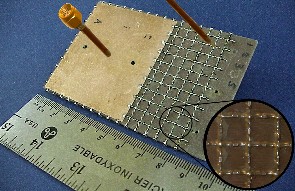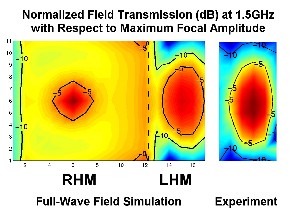PLANAR
L-C BASED NEGATIVE-REFRACTIVE-INDEX METAMATERIALS

Materials
with such exotic properties have the potential to radically change the
world of wireless communications, radar and surveillance. Their unique
characteristics will enable unprecedented levels of antenna miniaturization,
antenna beam steering, and signal switching and routing. In addition, the
technology may enable the creation of miniaturized RF lenses with a unique
sub-wavelength resolution capability [2], as well as ultra-fast signalling
between two points.
Recently,
novel electromagnetic metamaterials have successfully demonstrated negative
refraction and suggest an approach whereby the permittivity and permeability
functions are made to be simultaneously negative using an array of resonant
cells consisting of thin wire strips and Split-Ring Resonators (SRRs),
respectively [2]-[4].
Our research
has yielded a new class of LHM metamaterials that take a step further than
the original wire/SSR concept. These new LHM metamaterials consist of connected
unit cells that do not excplicitly rely on resonances to synthesize
the required negative material parameters. The unit cells are equipped
with (possibly tunable) lumped elements (inductors and capacitors), which
permit them to be compact and therefore scalable from the MHz to the
tens of GHz range. Moreover, these new metamaterials offer large
operating bandwidths, and are completely planar thus inherently supporting
2-D wave propagation making them well suited for RF/microwave device and
circuit applications [5], [6].
We have
verified through simulation that our structures exhibit negative refraction
and focusing. Furthermore, a 30mm X 55mm LHM prototype has been
implemented and tested around 2GHz. Recent experimental results demonstrated
focusing of an incident cylindrical wave over an electrically small area,
a phenomenon suggestive of near-field focusing.[5], [6].
Based
on the same concept of devising left-handed metamaterials, a backward radiating
planar antenna was implemented and tested at 15 GHz [7], [8]. This is perhaps
the first experimental demonstration of backward wave radiation from a
left-handed medium, an effect analogous to reversed Cherenkov radiation
originally predicted by Veselago [1].
In
the figures to follow, we provide a sample of the progress we have made
so far.

The refractive indices of
the RHM and LHM are +1.2 and -2.4, respectively. Refraction is observed
at -14


Figure
4: Focusing device: LHM prototype interfaced with a parallel-plate waveguide
(60mm X 95mm); the inset magnifies the surface of the LHM unit cell..
Figure 5: Correspondence of (a) full-wave field simulation results and (b) experimental results at 1.5GHz (normalized to the maximum respective focal amplitudes in each case).

REFERENCES
[1] V. G. Veselago, "The electrodynamics of substances with simultaneously negative values of e and m," Sov. Phys. Usp, vol. 10, no. 4, pp. 509-514, Jan.-Feb.1968.
[2] J. B. Pendry, A. J. Holden, D. J. Robins, W. J. Stewart, "Magnetism from conductors and enhanced nonlinear phenomena," IEEE Trans. on Microwave Theory and Tech., vol. 47, no. 11, pp. 2075-2084, Nov. 1999.
[3] D. R. Smith, W. J. Padilla, D. C. Vier, S. C. Nemat-Nasser, S. Schultz, "Composite medium with simultaneously negative permeability and permittivity," Phys. Rev. Lett., vol. 84, no. 18, pp. 4184-4187, May 2000.
[4] R. A. Shelby, D. R. Smith, S. Schultz, "Experimental verification of a negative index of refraction," Science, vol. 292, 6 April 2001, pp. 77-79.
[5] A.K. Iyer and G.V. Eleftheriades, "Negative refractive index metamaterials supporting 2-D waves." IEEE International Microwave Symposium Digest, pp. 1067-1070, June 2-7, 2002, Seattle, WA
[6] G.V. Eleftheriades, A.K. Iyer and P.C. Kremer, "Planar negative refractive index media using periodically L-C loaded transmission lines." Accepted in the IEEE Trans. on Microwave Theory and Techniques.
[7] A. Grbic and G.V. Eleftheriades, "A backward-wave antenna based on negative refractive index L-C networks." Proc. of the IEEE Intl. Symposium on Antennas and Propagation, Vol. IV, pp. 340-343, June 16-21, 2002, San Antonio, TX
[8] A. Grbic and G.V. Eleftheriades, "Experimental verificiation of backward-wave radiation from a negative refractive index metamaterial." Accepted in the Journal of Applied Physics.
[9] G.V. Eleftheriades, "Planar Negative Refractive Index Metamaterials Based on Periodically L-C Loaded Transmission Lines." Workshop of Quantum Optics, Kavli Inst. of Theoretical Physics, University of Santa Barbara, July 2002 (invited).
[10] G.V. Eleftheriades, A.K Iyer, A. Grbic and O. Siddiqui, "Negative Refractive Index Metamaterials Based on L-C Loaded Transmission Lines." Progress In Electromagnetic Research Symposium (PIERS), July 2002, Boston.
[11] G.V. Eleftheriades, O. Siddiqui and A. Iyer, "Transmission line models for negative refractive index media and associated implementations without excess resonators." Accepted in the IEEE Microwave and Wireless Components Letters.